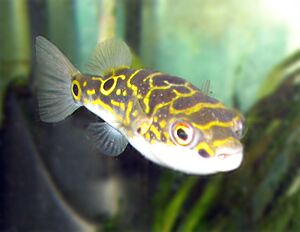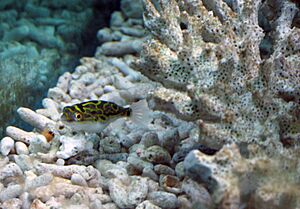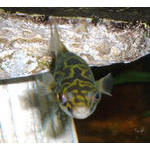Dichotomyctere ocellatus facts for kids
Quick facts for kids Dichotomyctere ocellatus |
|
|---|---|
 |
|
| Conservation status | |
| Scientific classification | |
| Synonyms | |
|
Tetraodon biocellatus Tirant, 1885 |
The Dichotomyctere ocellatus, also known as the figure 8 puffer or eyespot puffer, is a type of pufferfish. You can find it in freshwater and slightly salty (brackish) waters in Southeast Asia. It lives in places like the lower parts of the Mekong River in Cambodia, Peninsular Malaysia, and Borneo.
Contents
What Does It Look Like?
Figure 8 puffers can grow to about 8 cm (3 in) long. They are very colorful fish. Their backs have cool greenish-yellow patterns. These patterns are different on each fish. But the marks near their tail often look like the number eight. Sometimes they look like eye-spots, which is why they are also called "eyespot puffers."
Compared to other pufferfish, figure 8 puffers are quite peaceful. They can sometimes live with other fish like bumblebee gobies and mollies. But remember, all pufferfish can be a bit unpredictable. So, there's always a chance they might not get along with tankmates.
Just like all pufferfish, the figure 8 puffer can puff itself up. When it feels scared or stressed, it can quickly fill its body with water or air. This makes it look much bigger to scare away predators.
Where Do They Live? (Fresh or Salty Water?)
The figure 8 puffer is special because it can live in different kinds of water. It can adapt to both freshwater and slightly salty, or brackish, water. This is why some people think they only live in freshwater.
These fish are very good at changing their bodies to fit the water they are in. If the water gets saltier, their bodies adjust. If it becomes less salty, they change again. This amazing ability helps them survive in many different places.
Keeping Them as Pets
If you want to keep figure 8 puffers as pets, they need a tank of at least 15 US gallons. The water should be warm, between 24 °C and 28 °C (75–82 °F). These fish are sensitive to bad stuff in the water, like nitrites and nitrates. So, you must put them in a tank that has been "cycled." This means the tank's filter system is ready to handle fish waste.
It's a good idea to have extra strong filters. You should also change part of the water often. The water's pH level should be between 7.8 and 8.3. Adding special marine salt helps keep the water at the right pH. The water should be slightly salty, with a specific gravity of 1.005 to 1.008. If cared for well, these puffers can live for up to 15 years!
Pufferfish need a fun and interesting tank. Add lots of hiding spots, caves, and plants. This helps them act like they would in nature. It also keeps them from getting bored.
What Do They Eat?
Pufferfish are known as "molluscivores." This means they mostly eat creatures with shells, like snails, mussels, and oysters. They also like krill. Some puffers might eat flake food, but it's not the best main meal for them.
Their teeth are like a strong beak made of two plates. This beak is perfect for crushing shells to get to the yummy food inside. In an aquarium, many fishkeepers feed them snails. Snails are great because they help keep the puffer's beak trimmed. If their teeth don't get used, they can grow too long.
Images for kids





